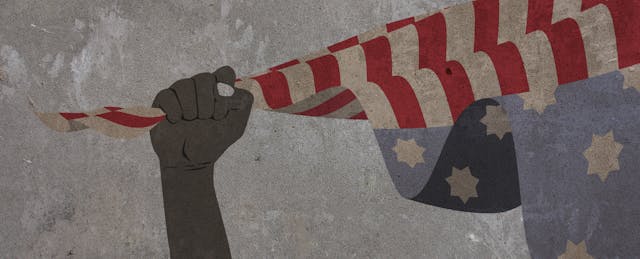What do you remember from history class? For Americans of every generation the answer might be “not much.” To history teacher Joe Welch, too many of today’s lessons still call to mind Ben Stein’s classic classroom lecture in “Ferris Bueller’s Day Off.” (Anyone? Anyone?)
Welch, an 8th-grade teacher at North Hills Middle School in Pittsburgh, is charting his own path—one that doesn’t include a textbook. Recently named National History Teacher of the Year by the Gilder Lehrman Institute of American History, Welch, at 33, is the youngest recipient in the award’s 14-year history.
At a time when politics, history and civics are constantly colliding in the news cycle, Welch’s win seems fitting: he’s a big believer in getting kids to form empathetic connections with historical subjects, which can help them see events from multiple perspectives.
EdSurge recently spoke with Welch about his unique storytelling approach, the value of in-class debates, when using technology makes sense and, of course, the musical “Hamilton.” The conversation has been lightly edited for length and clarity.
EdSurge: U.S. schools are not well-known for teaching students history and getting them to remember it. How do we move the needle on this in a meaningful way?
Joe Welch: When I was first starting out, I thought I had made one of the best lessons ever about the Cold War. I was probably in my second month of teaching and I fit in all the elements of a good lesson: I had a hook, I had a discussion, I had some multimedia. I thought, “This is going to be great.”
But I was looking at kids and they were just kind of staring at me. As teachers I think we all know that look, like, “When’s this period over?”
My co-teacher pulled me aside afterward because I think he realized I was getting frustrated. He asked me, “What did you learn today?” I replied, “Well, maybe I should have used a different video clip. Or maybe I should have framed the discussion a certain way.” He said, “No, what you learned today is students don’t walk in here learning to love history.”
It really was transformative. I began thinking about how to make a student emotionally invested. How can I get away from that whole spin, wash, repeat cycle of: Here’s the study guide, take a test, forget what you learned, repeat?
I do that by connecting them with a personal story and allowing students to tell that story. I can go to former students who read primary sources from Jamestown of people’s personal perspectives and ask those students about the emotions those colonists went through and what they wrote about. It’s not just that they read it—students have to become part of that story and tell that story.
It’s really looking at different ways for students to get involved. There may be students that enjoy telling a story via animation, or making a video or writing a song in GarageBand about somebody else’s perspective. That’s when you learn it—whenever you have to find a creative way to explain it to somebody else, and you’re investing your own emotion and time gets away from you.
It reminds me of the quote: “They may forget what you said—but they will never forget how you made them feel.” To remember historical times or historical characters, we need to think of people as characters in a story as opposed to just people that are no longer here. I think you feel a little more connection.

History is not a subject typically found on standardized tests like the SATs. How can schools really make it a priority?
Sometimes it’s a blessing that we don’t have standardized tests because we don’t have to teach to a test. That’s kind of cliche, but it lets us do a lot of the creative things that we do. Students can take some time and actually produce things, as opposed to getting ready for a standardized civics test.
Going back seven or eight years ago, another colleague and I pitched an idea: Why don’t we move away from the standard use of a textbook? Let’s get away from that “Ferris Bueller” mentality where there’s a history teacher up in the front of the room lecturing, you’re taking notes, you take a test and then you instantly forget what you just learned.
Let’s use primary sources as the base of all of the knowledge that we’re going to get in this class. But let’s not stop there: students are going to analyze these primary resources and then they’re going to tell a story based on somebody else’s perspective—and in creative ways.
At the same time, I work closely with the English language arts teacher. And as we’re looking at all these different resources, students are actually picking up these skills that are assessed on standardized tests, whether it’s looking for bias or analyzing evidence in an argument or analyzing evidence in a primary resource. You can do creative things and still teach the basics.
How do we get more kids invested in civic engagement?
I’m a big “Hamilton” fan and there’s an obscure line in one of the songs that goes, “When you got skin in the game, you stay in the game.” If we’re getting kids involved in history and how we learn things and how our nation came to be and how the political landscape has formed, they’re going to stay involved. But if they check out in middle school and they check out in high school, they’re more prone to believe whatever they see later on and they’re not going to be engaged.
We live in a meme society right now, where sometimes people see a meme and they instantly share it without analyzing it. The question is: How do we create students that are involved and engaged so that we have educated discourse.
That’s a good point. The U.S. has an almost theoretical legal framework that’s pretty open to interpretation. How do good teachers contextualize current events—such as whether you can indict a President or what the Second Amendment is—through a historical lens for students?
Even our Founding Fathers disagreed about things. We see their notes, we see their writing, we can see them fighting back and forth with each other. But they all had a common ideal of what America should be. That’s what they were fighting for. We have debates now partly because they were debates that were never really rectified way back when.
You referenced indicting a President. Is it constitutional? Unconstitutional? These are things that sometimes there are past precedents for.
I think it’s a great way to engage students. “What would the Founding Fathers have said about this?” There is no correct answer, so it’s a really great way to get students involved. At times it can get heated and kids get really almost too involved with it. But I think when you bring out emotion in students and they really feel a certain way, that’s not a bad thing. They feel invested and they feel like they want to learn more. When you have students going home and they want to bring additional information into class, that’s a great thing.
Have you introduced your students to “Hamilton?”
Absolutely. We’ll listen to all of the “Hamilton” songs but it’s more than just listening to it. It’s looking at how Lin-Manuel Miranda based it off primary sources. I almost use it as inspiration: as this man read all of these sources, he saw it as a hip-hop musical. You may see America’s story as a metaphor for analysis to something you enjoy. And really, the students like the music. I’ll have students come in at the beginning of the year and say, “Oh, my sister loves ‘Hamilton.’” They’re 8th graders so they might play it off as “not cool” but by the end if the year, they’re enjoying it immensely.
What are some of the technology tools you use and what projects are students using them for?
I’ve been teaching in a 1:1 environment, so every student with an iPad is drawing a graphic novel. They’re taking George Washington’s journal and asking themselves how they view the experiences that he’s describing. We have students who are great artists and we have students who are struggling artists or reluctant artists, but whenever they create that finished graphic novel it’s really something.
I’ve also had students conduct their oral history research project by connecting firsthand with people who experienced certain events. They used technology to interview them, obviously, but then they created an iBook out of that. We actually had four volumes of oral history iBooks that were available in the Apple iTunes store—and everybody in the community could access them. It’s documenting not only what a student learned, but the contributions of everybody that they had interviewed. We had people using technology to FaceTime relatives in China in South Africa, and we had one student actually interview a former prisoner of war who served in Vietnam.
I don’t want to give you a list of endless apps. The power is in using that technology to connect and create. There are some fancy bells and whistles but if there’s no connection to the past, and there’s no connection with what you’re actually doing, it’s really no different than not using technology. It’s a tool that’s there to augment good practice.
Being a teacher can be hard these days. What advice would you give to a new teacher who’s interested in history?
It’s such an enjoyable, rewarding career—especially when students give you that look of, “Wow, I didn’t know that,” or, “Can we change how this is?”
If you make a mistake or it doesn’t go as planned, it’s OK. You’re going to go home, you’re going to regroup and you’re going to think of something even better the next day. My advice to young teachers is to go for it. Take a risk, be dynamic, continue to learn. I don’t want to come off as disrespectful, but don’t do what’s in the textbook guide. Be yourself.


